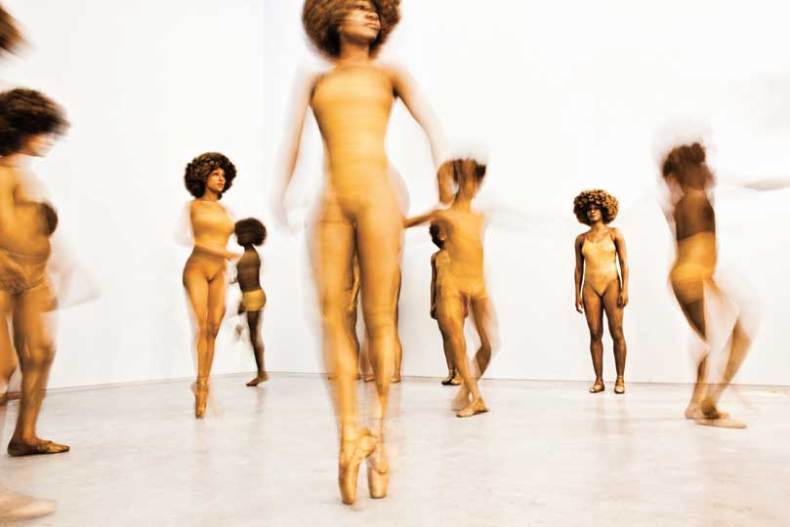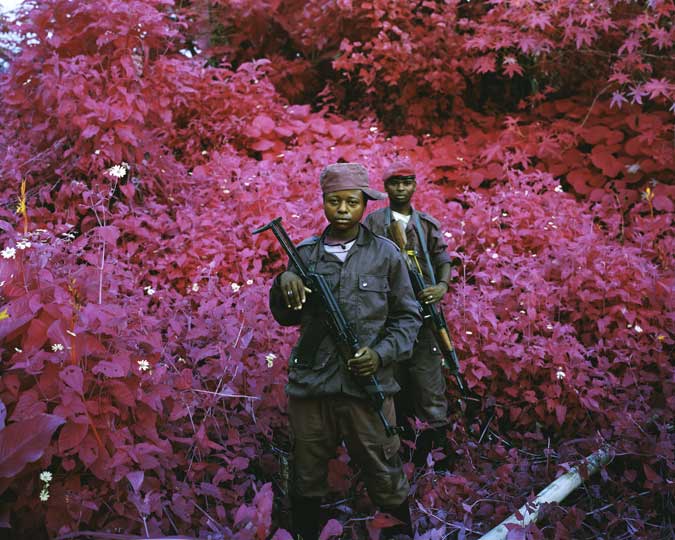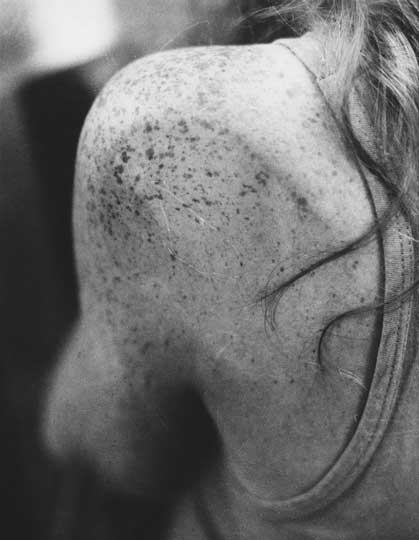Photography sits uncomfortably as a medium among the visual arts. Compared to some, it’s an upstart – thousands of years younger than painting or sculpture, centuries younger than its closest sibling, printing. Its age relative to video and digital art settles it, perhaps, in the position of the difficult middle child. Boisterous, graphic, easily led astray: photography is rarely treated with the care or respect enjoyed by other media.

Momentum (still; 2011), Lorna Simpson © Lorna Simpson. Courtesy of the artist and Salon94, New York
Mostly, it is not art – or at least, it is difficult to define it so clearly. Our world has been plastered with photographs for generations. Photography has become a vernacular medium, particularly since the introduction of digital cameras and, more explosively, smartphones. It’s a medium for documenting, reporting, and for saving information so that we can recall it later. It’s a medium available to us at a single click: one many of us use as a short-cut for explaining experiences that would take longer to recount in words.
Yet while we draw on photographs as reflections of reality, we are increasingly aware of their ability to misrepresent the truth, and their meaninglessness when seen without context. A photograph presented to a friend over a pub table is often accompanied by the phrase ‘I guess you had to be there’.

My feminine side (2002), Alberto García-Alix © Alberto García-Alix. Courtesy of the artist
This crisis in identity for photography should provide a tangle of concepts and associations for artists to unpick, expose and review. A look at the nominees for this year’s Deutsche Börse prize at the Photographers’ Gallery in London suggests that this is an objective for both photographers and curators. The works and artists in the exhibition present new angles on a number of common functions of photography. Richard Mosse brings an examining eye to photojournalism and war photography through his lurid re-presentation of the Democratic Republic of Congo; Lorna Simpson explores replication, repetition and the role of the observer in a collection of found images; Alberto Garcia-Alix presents his own take on the self-portrait; and Jochen Lempert takes another look at nature with a healthy pinch of dark-room abstraction.

Man-Size (2011), Richard Mosse © Richard Mosse. Courtesy of the artist and Jack Shainman Gallery
Yet the exhibition itself is not as arresting or inquisitive as it should be. Each of these artists (with the exception, I think, of Lempert) seems to use the camera as a tool to locate their subject and question it from a safe distance, rather than bringing it closer to the viewer. Take the photographs exhibited by Mosse: they’re not about the DRC, or the experience of living there. They’re about photographing life and conflict in Africa. The ‘subject’ of the image is repositioned as an object, and we’re drawn into collusion with the photographer to become the self-aware subject of the work. Art turns into social satire. Last year’s show was similar: Mishka Henner and Broomberg and Chanarin severed themselves from their subjects by using archived and found images, while Cristina De Middel drew attention to the perceived cultural and technological remoteness of Zambia in the 1960s.

Untitled (girl in a telephone booth) (1993/2011), Jochen Lempert © VG Bild-Kunst, Bonn, for Jochen Lempert. Courtesy of ProjecteSD, Barcelona
This distance limits the possibility of discovering anything new about or through the photography on show: it might help us to identify our own preconceptions, but doesn’t cause us to question them deeply. This might be a problem with the way that pictures are exhibited (photographers such as Teresa Eng use the tactile nature of the photo-book to dissolve the barriers between viewer, photographer and subject), but it is a problem nonetheless. In choosing to use a vernacular medium such as photography, artists and curators need to demonstrate their fluency with it. They ought to produce poetry rather than satire.
The Deutsche Börse Photography Prize is at the Photographers’ Gallery, London, until 22 June.
Related Articles
Richard Mosse’s ‘The Enclave’ on display in London (Lily Le Brun)

Deutsche Börse Prize: are photographers making the most of the medium?
Untitled (four swans) (2006), Jochen Lempert © VG Bild-Kunst, Bonn, for Jochen Lempert. Courtesy of ProjecteSD, Barcelona
Share
Photography sits uncomfortably as a medium among the visual arts. Compared to some, it’s an upstart – thousands of years younger than painting or sculpture, centuries younger than its closest sibling, printing. Its age relative to video and digital art settles it, perhaps, in the position of the difficult middle child. Boisterous, graphic, easily led astray: photography is rarely treated with the care or respect enjoyed by other media.
Momentum (still; 2011), Lorna Simpson © Lorna Simpson. Courtesy of the artist and Salon94, New York
Mostly, it is not art – or at least, it is difficult to define it so clearly. Our world has been plastered with photographs for generations. Photography has become a vernacular medium, particularly since the introduction of digital cameras and, more explosively, smartphones. It’s a medium for documenting, reporting, and for saving information so that we can recall it later. It’s a medium available to us at a single click: one many of us use as a short-cut for explaining experiences that would take longer to recount in words.
Yet while we draw on photographs as reflections of reality, we are increasingly aware of their ability to misrepresent the truth, and their meaninglessness when seen without context. A photograph presented to a friend over a pub table is often accompanied by the phrase ‘I guess you had to be there’.
My feminine side (2002), Alberto García-Alix © Alberto García-Alix. Courtesy of the artist
This crisis in identity for photography should provide a tangle of concepts and associations for artists to unpick, expose and review. A look at the nominees for this year’s Deutsche Börse prize at the Photographers’ Gallery in London suggests that this is an objective for both photographers and curators. The works and artists in the exhibition present new angles on a number of common functions of photography. Richard Mosse brings an examining eye to photojournalism and war photography through his lurid re-presentation of the Democratic Republic of Congo; Lorna Simpson explores replication, repetition and the role of the observer in a collection of found images; Alberto Garcia-Alix presents his own take on the self-portrait; and Jochen Lempert takes another look at nature with a healthy pinch of dark-room abstraction.
Man-Size (2011), Richard Mosse © Richard Mosse. Courtesy of the artist and Jack Shainman Gallery
Yet the exhibition itself is not as arresting or inquisitive as it should be. Each of these artists (with the exception, I think, of Lempert) seems to use the camera as a tool to locate their subject and question it from a safe distance, rather than bringing it closer to the viewer. Take the photographs exhibited by Mosse: they’re not about the DRC, or the experience of living there. They’re about photographing life and conflict in Africa. The ‘subject’ of the image is repositioned as an object, and we’re drawn into collusion with the photographer to become the self-aware subject of the work. Art turns into social satire. Last year’s show was similar: Mishka Henner and Broomberg and Chanarin severed themselves from their subjects by using archived and found images, while Cristina De Middel drew attention to the perceived cultural and technological remoteness of Zambia in the 1960s.
Untitled (girl in a telephone booth) (1993/2011), Jochen Lempert © VG Bild-Kunst, Bonn, for Jochen Lempert. Courtesy of ProjecteSD, Barcelona
This distance limits the possibility of discovering anything new about or through the photography on show: it might help us to identify our own preconceptions, but doesn’t cause us to question them deeply. This might be a problem with the way that pictures are exhibited (photographers such as Teresa Eng use the tactile nature of the photo-book to dissolve the barriers between viewer, photographer and subject), but it is a problem nonetheless. In choosing to use a vernacular medium such as photography, artists and curators need to demonstrate their fluency with it. They ought to produce poetry rather than satire.
The Deutsche Börse Photography Prize is at the Photographers’ Gallery, London, until 22 June.
Related Articles
Richard Mosse’s ‘The Enclave’ on display in London (Lily Le Brun)
Unlimited access from just $16 every 3 months
Subscribe to get unlimited and exclusive access to the top art stories, interviews and exhibition reviews.
Share
Recommended for you
Curator Chic: are arts professionals the new fashionistas?
A curator’s work is all about looking, and being looked at